Four years in New England. Three more in the West. The last almost-decade of my angling life has been filled with new species, thousands of hours on the water, and fisheries that had just as much to offer as I had passion to throw into them. I’ve been busy, and I’ve been lucky. Then I got hit with the two biggest obstacles every non-professional obsessed fly angler comes across in their lives: the real world, and living in New Jersey.
I moved from Oregon back to my home state in the spring of 2023. This inevitably came with a drastic change of scenery, a great deal of culture shock, and, pertaining to this blog, a considerable decline in world class year round fly-fishing waters. Angling here wasn’t a blank slate by any means. I had learned to fish and fly-fish in New Jersey having grown up here and am no stranger to pulling the best out of the most un-fishy of places. However, the adventure with a fly rod I’d hungered for in my childhood had matured into something I’d equate more to a life support system. Without the consistent access I’d grown accustomed to, I’d wither like the dust-choked grass on the shoulder of the Garden State Parkway.
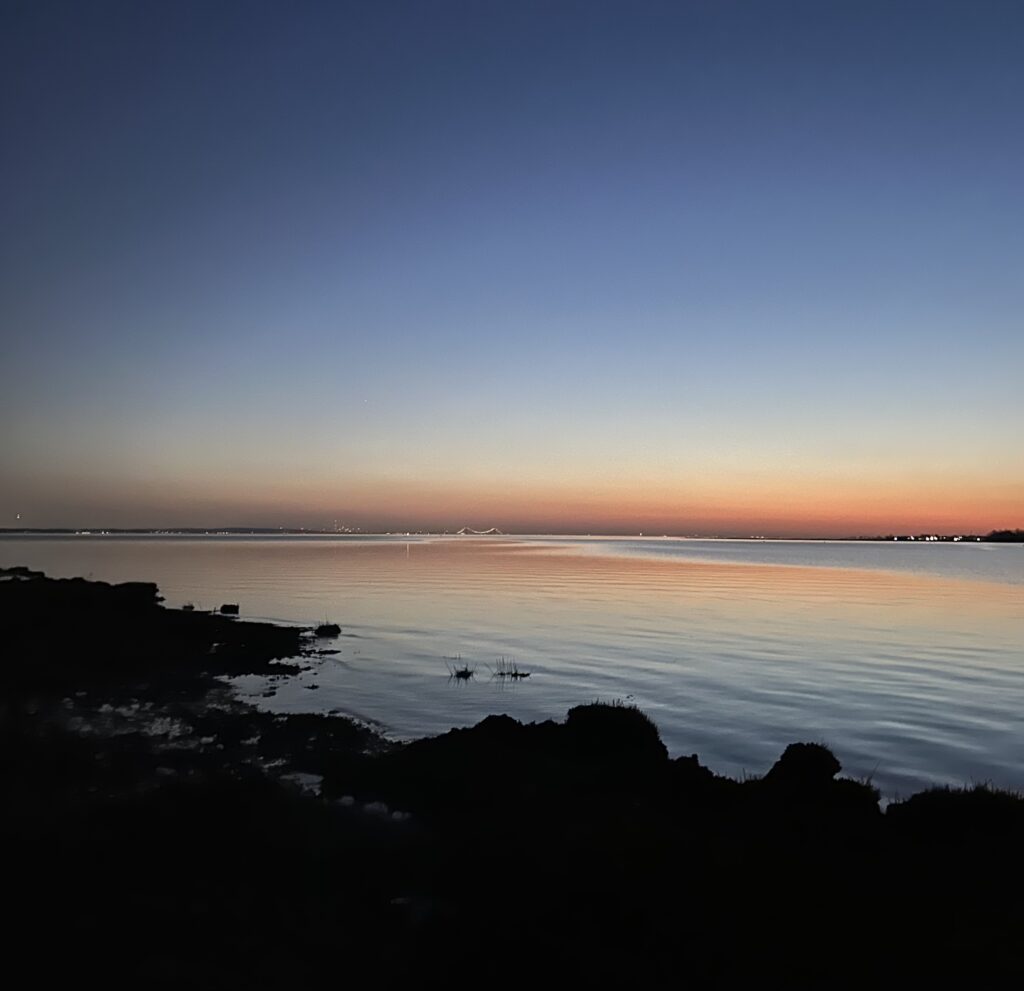

Settling into my new job limited me to the occasional visit to a few waterways I fished in high school, but I knew it wasn’t long before I’d need to branch out. I already had a few plans on the calendar to head North to some seriously good fisheries in New England, but any dedicated angler knows that you can’t be satisfied (or skilled) from the occasional big fishing trip. I’d need to fish where I live.
My first glimpse at salvation came in carp form. I had swung by a local pond on a whim when I saw one of these golden behemoths nosing around in a foot of clear water. A quick lap around the park revealed pods of fish ranging from a couple of pounds up to some double digit numbers in weight, lazily grazing on the mud flats. I returned later with my five weight and few slow sinking nymphs, and just a few days into my return had a carp fishery and some very confused pedestrians all to myself.


Where I’m from in New Jersey, walking around in public with a fly rod and a net receives an attention level equivalent to being out and about in a clown suit. I have since gotten used to it, but I always hold a little apprehension towards the time it takes me to pull up to one of these upscale suburban neighborhoods and actually get to where I want to fish. Once I’m on the water I feel perfectly comfortable, but it’s that in-between where you’re slinking to your spot feeling like you’re doing something illegal that’s always a bit awkward.
The next part of your classic urban fishing interaction comes from the smaller group of recreators that actually acknowledge your existence. I generally divide the two types of people that come talk to you on the water into non-anglers and anglers, and the differences between the groups are the same whether you’re on a famous western stream with a popular hiking trail or an East Coast bike path along an obscure warm water fishery. Non-anglers always approach with genuine amazement and a comment about how you’re fishing where you are or that there are actually good sized targetable fish in a place they walk past every day, or a mix of the two. They’ll often whip out their phones and take pictures of a fish you’ve landed either to show their buddy that fishes or because you asked them to grab a quick shot for your stupid blog. A question about whether you’ll be eating that carp from the fertilizer-stained park pond is also commonplace.
The anglers are usually prouder. They’ll bypass the questions about the fishery or target species by hitting you with an “any luck?” if they catch you in between spots, then nod approvingly in a “sounds about right” kind of way at whatever you answer. This usually results in a quick, boring conversation within the larger context of an unspoken ego standoff where the angler is too cool to ask questions where they might learn something, but interested enough to approach the situation. I like the non-anglers better.


That summer I’d end up fine tuning my carp skills on the ponds near my house and beyond, even taking my talents to what must be one of the world’s premier urban carping destinations: New York City’s Central Park. The fish’s wariness, size, and fighting abilities made them an excellent target, but it wouldn’t be long before I started hitting dead ends. My local pond was already drying up by June, eliminating the best shore locations for targeting carp and making sneaking up on the fish in the diminishing shallows almost impossible. There were plenty of other carp-habitable looking ponds around me, but I failed to find any fish besides bluegill and bass when I went to check them out. East Coast warmwater fisheries are incredibly dynamic, and a year-round commitment to successful fly-fishing here requires constant changes in locales and species. It was clear I’d need to switch things up.
Carp weren’t prevalent in my mind when planning my return to the northeast, but pike were. The last time I had caught these predatory missiles was during a particularly awesome spring window in 2021, when fellow Long Haul contributor Jack and I were both still living in Vermont. They were a common target for us in New England, but I had also dialed in a few spots in Jersey when I’d visit home. Now that I was back, it was time to expand on the groundwork I’d laid for pike fishing in the Garden State.
If you’re a multispecies fly angler, odds are you’ve had some issues keeping up with the vast array of random gear one acquires while following different fish through the seasons. When I laid eyes on my big streamer box after two years of predominantly trout fishing, I began hoping the pike weren’t feeling too picky that day. The few flies I had left were either pretty experimental and poorly tied or ripped to shreds from my last pike outings up North. I dusted off one of my more intact creations and clinch-knotted it to a short, wire tipped leader.
Despite popular belief, northern pike aren’t native to New Jersey. They’ve been stocked in waters throughout the state for a number of years and have since established themselves in the most unlikely of places, such as the slow-moving sludge of a river I was currently hiking towards.


When someone from Jersey names a place that you “probably shouldn’t go to”, it’s usually because of general crime avoidance/safety purposes or the odd bad bagel store. As I’ve found from my years of fishing here, there’s another surprising category of environment in one of the most populated states in the country that doesn’t see much of the outside world: wilderness. Webster’s Dictionary defines wilderness as “a tract or region uncultivated and uninhabited by human beings” (yes, I went there, and yes, it does). If you’re willing to go soft on the “uncultivated” part, there are in fact huge expanses of forest less than an hour from New York City that see almost no people. They’re not easy to get to, and once you’re there they are not pretty. But if you do find the urge to cut through football-field length swaths of invasive brambles and rebar, you’ll discover an unlikely world teeming with life.
You wouldn’t believe that where I’m fishing doesn’t get visited. There’s trash everywhere, ranging in size from plastic bags to rusty shopping carts. This spot is on a massive floodplain and its man-made additions have come from miles upstream, greatly polluting the river at its center but leaving the area quite undesirable for visitors. You can hear some of the busiest highways on the East Coast in the distance, but there are no trails here except for the muddy paths worn by its year-round feral residents. Despite its appearance I’ve seen more wildlife at this spot than probably anywhere else in the state. Deer, otters, foxes, and coyotes are active without constant foot traffic, and I usually spook a variety of the aforementioned animals out when I visit. Wildlife is all around you even in New Jersey, but I always find it a little eerie going to the few places remote enough in the state that the creatures aren’t afraid of you. Despite its relative proximity to millions of people, no one comes within miles of here. If something were to happen, you’d have a hard time getting found. It’s all in this weird gray area where the pollution and outside presence of so many humans actually creates a place that is not actively pressured at all. This is where the best pike fishing in the Garden State is.


I sloshed my way through the flooded forest, taking shots at logjams and muddy backeddies with my eight weight. There’s often more walking than fishing in these stretches, and every good spot requires a bit of planning. There may be plenty of ambush areas for pike to lurk and assault unsuspecting prey, but reaching them with a fly is another story. The riverbank’s quick drop off and muddy bottom makes wading basically impossible, and a few feet of backcast room from the shore is a rare blessing. However, in those few instances when you rip out the other side of a bramble patch and manage a good first cast behind some current breaking structure, you can’t help but tense up during every pregnant pause between strips for a take.
But not today. The falling water from recent rains and overcast cover had set up a decent bite window, but spot after spot I came up empty. I started working through my already depleted streamer box. I almost never change flies when I’m pike fishing, but I had been messing with patterns of different weights all day due to the water being a bit higher than I had remembered. Now I pulled out a giant white monstrosity: an oversized cone head kokanee salmon pattern meant to target bull trout in the depths of Oregon’s Metolius River. The fly made threading casts between the trees even more of a nightmare, but it sank fast into the short sections of good slack water.
Finally, I hooked up behind another juicy looking stretch of cover. The fish shook hard and tried to dart back around the series of stumps where it had eaten. It was heavy, but the early fight felt more like that of a largemouth bass than the initial blistering run of a pike. I leveraged the strength of my fourty-pound leader and wrenched the fish into open water. When it came up to the top and rolled I saw that not only was it not a pike, but a completely new species to me on the fly: a channel catfish, and not a bad one either. The stakes immediately became higher in a way only anglers that have hooked their first or biggest of any species will understand. After a few more surprisingly strong runs towards the unseen minefield of junk on the river bottom, the cat came within reach of the muddy bank and I made a lucky stab with my net. The single barbless hook came out almost immediately and I grabbed a few awkward selfies with my new lifer species before I slid it back into the muck, leaving me with another mangled streamer and a slime-covered leader. An old spot, a new fish, and a fly tied for the other side of the continent. I still wasn’t sure about my decision to move back here, but I’d take this as a sign from the fish gods that I was doing something right.


I may not have caught any pike that day, but it wasn’t long before I started settling back into a groove. I continued fishing through good bite windows, pulling out a few fish here and there during spring rains and cooler days. I pored over satellite images of marshlands and culvert outflows, and discovered pods of bait and lurking esox on my visits. The season progressed. I hit carp ponds on my lunch breaks and would head out after work to chase pike and pickerel. Summer evenings became synonymous with casting into schools of nervous shiners in the twilight, the soft endless rumble of distant turnpikes, and the occasional violent strike that would break the whole lull. It wasn’t perfect, but it was high quality fishing and I was always completely alone.
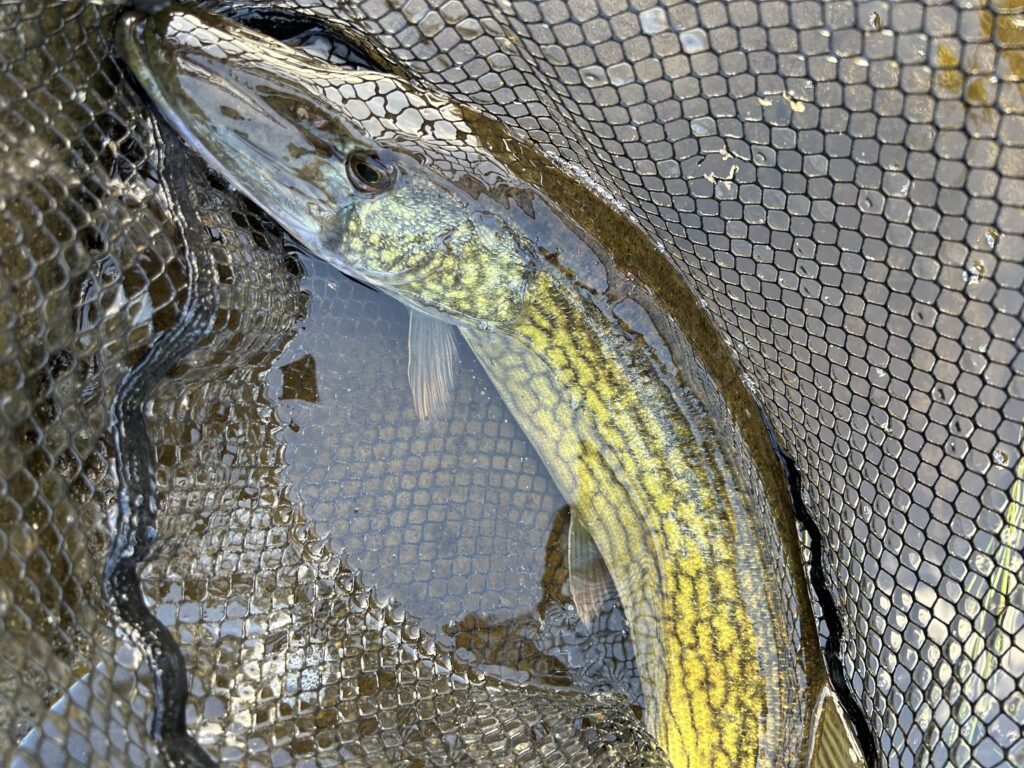

You know something needs to change within your life when you feel off despite the fishing being good. By September, after six months in Jersey, I made a commitment: I was going back to Oregon for a little longer. It was a snap and confusing decision, but I felt great about it once I made the call. In the time before my departure, I felt I owed it to myself to finish my fishing efforts off strong.
An early Fall outing started as another pike mission. It was one of those days structured just enough that you’re confirmed to spend the whole day fishing, but are not completely sure where you’ll actually turn up by the end of it. After several days of heavy rain and reports of questionably high flows all around, it was at least good to be in a flexible mindset. I dredged heavy streamers into the mud for a couple of hours with no luck before I decided to switch things up.
Back in the car, I zoomed out on my heavily notated satellite map of New Jersey and picked out blue lines from the mosaic of towns and four lane highways. I settled on a cluster of points of interest I had marked and forgotten about— a few combined miles of tiny creeks in the relatively remote northern section of the state. I wasn’t planning on trout that day, but the rain-cooled water temperatures and high flows may have made these tiny high gradient streams the only fishable rivers within hours. I confirmed my 7’6’’ three weight was rolling around in the trunk of my car, and forty minutes later I stood studying a high but clear brook at the mouth of a dark hollow.
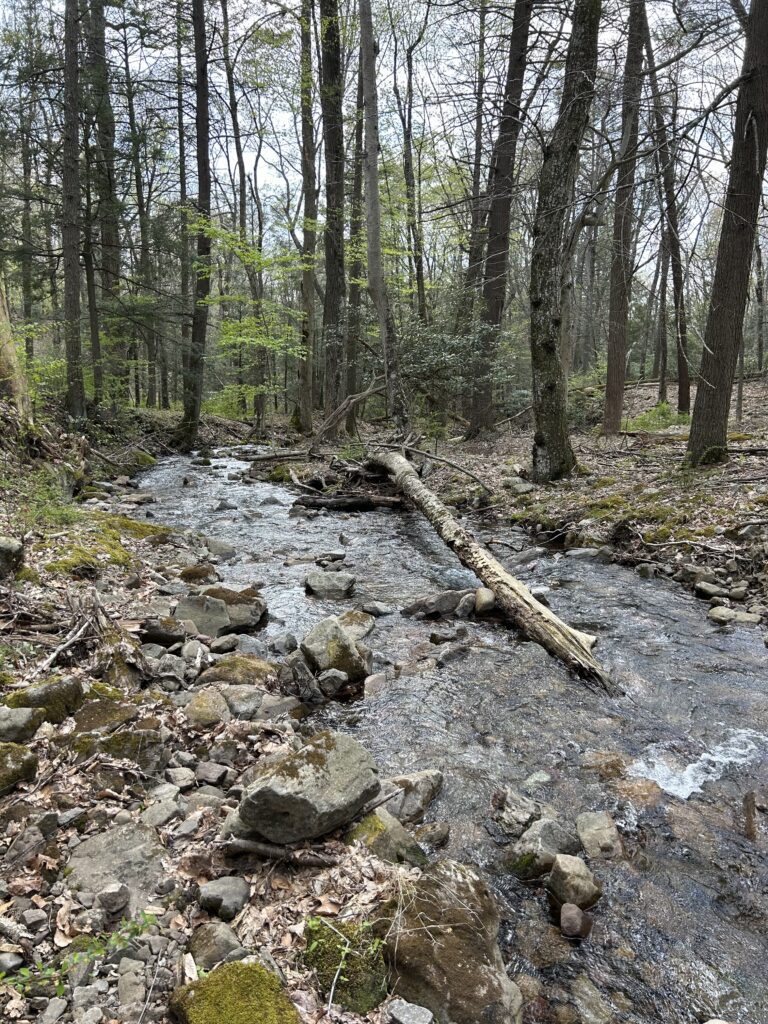

This was actually the third creek I had tried to fish since switching gears. The first turned out to be on private property and the second looked good but only yielded a few small dace (I suspect it was normally too warm to hold trout). This final stream was a complete guess, conveniently in the drainage adjacent to the spot I had just tried to fish. I was losing some hope, but every time I left one of these creeks and crossed the massively blown-out bigger river at their confluences, I was reminded that I didn’t have many options besides continuing to explore these hills. At least I’d been able to cross off a few mystery spots I’d had in my database.
Little first order streams are a great plan after rain eliminates a lot of your other options, but even here the high water can be deceiving. A normally unproductive trickle can become a tantalizing plunge pool with even a slight increase in CFS, but that doesn’t always make it fishier. Trout don’t always move into these areas just because they become temporarily habitable, but clueless fishermen that don’t know what the creek looks like in normal flows will spend too much time in one of these spots anyway. After an hour of slowly moving through what looked like the best water I’d seen all day, I was beginning to feel like I’d fallen victim to this time consuming error.
I moved downstream and skipped a long section of flat water that I suspected wasn’t as productive as it currently appeared. The stretch culminated in a massive logjam that held a mat of foam from the previous days of violent current. I switched over to a small jig streamer, sent the fly deep into the mess, and got hammered by a fish that I lost after a second.
The gradient increased and I encountered my first section of deeper runs and plunge pools. In one of the first riffles after my logjam miss, my streamer got whacked again and the fish stuck. It was just what I had hoped for: a fat brook trout, and my first NJ native in months. The brookies came quickly after that as if a switch had been hit. I swung my bugger across plunge pools and dropped it into deep nooks off ledges of exposed bedrock, and the char continued to respond in numbers. What started as a rainy day dredging for a couple pike had turned into an afternoon in the mountains on a high density brook trout stream I hadn’t known existed just an hour ago. With the trials and setbacks of my relocation in the spring and the confidence I had reestablished in my home state coming to mind, the day was becoming one of my top moments of fishing in New Jersey.
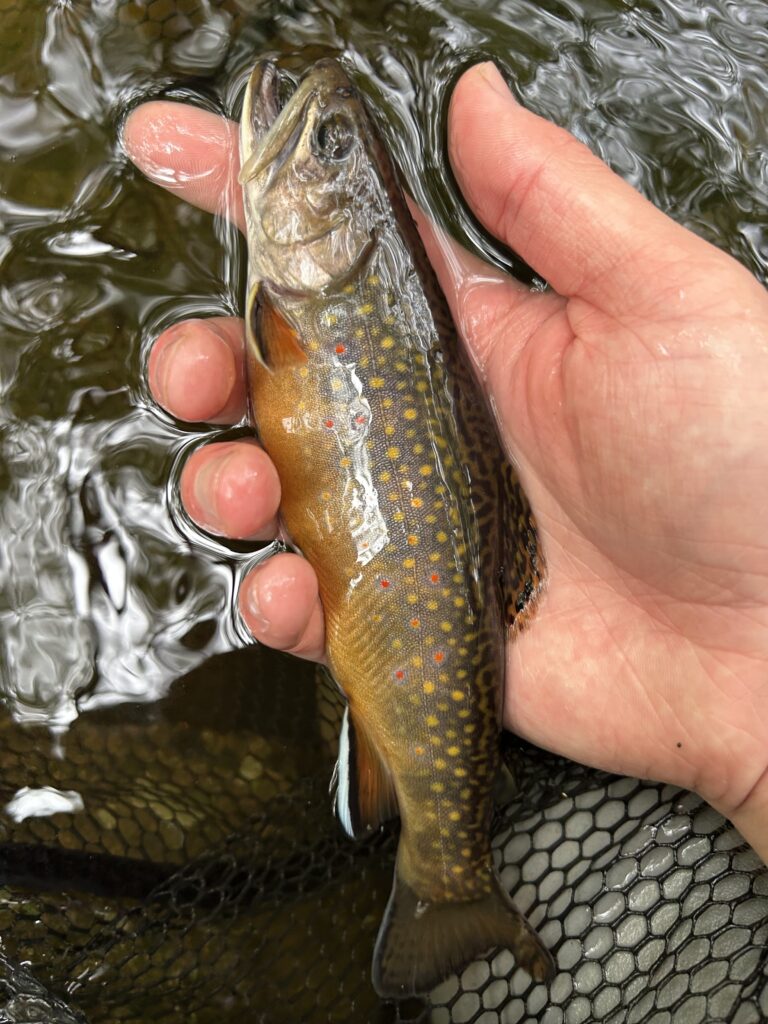

My level of excitement for this turnaround also probably had something to do with brook trout being my favorite fish of all time. This population of brilliantly colored char was a relic thousands of years old, settlers in these worn down mountains long before the ruins of the mills and homesteads I hiked past were even a thought. Their ancestors had survived mass extinctions and the relatively recent centuries of heavy development, clinging to their steep Appalachian mountain sides like the mist. I’ve always felt a funny connection with them—two NJ natives, out of place in its larger setting but right at home in these forgotten woods, although one party was definitely more happy than the other about this outcome.
I didn’t mean for it to turn out this way, but the trip ended up being the last fishing outing of my Garden State summer. Waders were dried and rods stowed for my flight out West, and I’d be leaving my brookies, bass, and pike behind for a little while. I can’t lie—I really don’t like New Jersey that much, but the fact that the sentiment has spread to people that have never even visited always left a bad taste in my mouth. In Bend, I’ve had people I don’t know hate a little too hard when I tell them where I’m from (great garbage joke, random brewery patron. Now tell me what neighborhood in San Francisco you moved here from last year). I get it, it’s an acquired tolerance. For people that have grown up with amazing wilderness at their fingertips, the prospect of moving to a place with more superfund sites than state parks might be terrifying. But at the end of the day, if you truly love what you love you’ll seek it out. Once you do these places take on a whole new meaning, culture, and purpose.
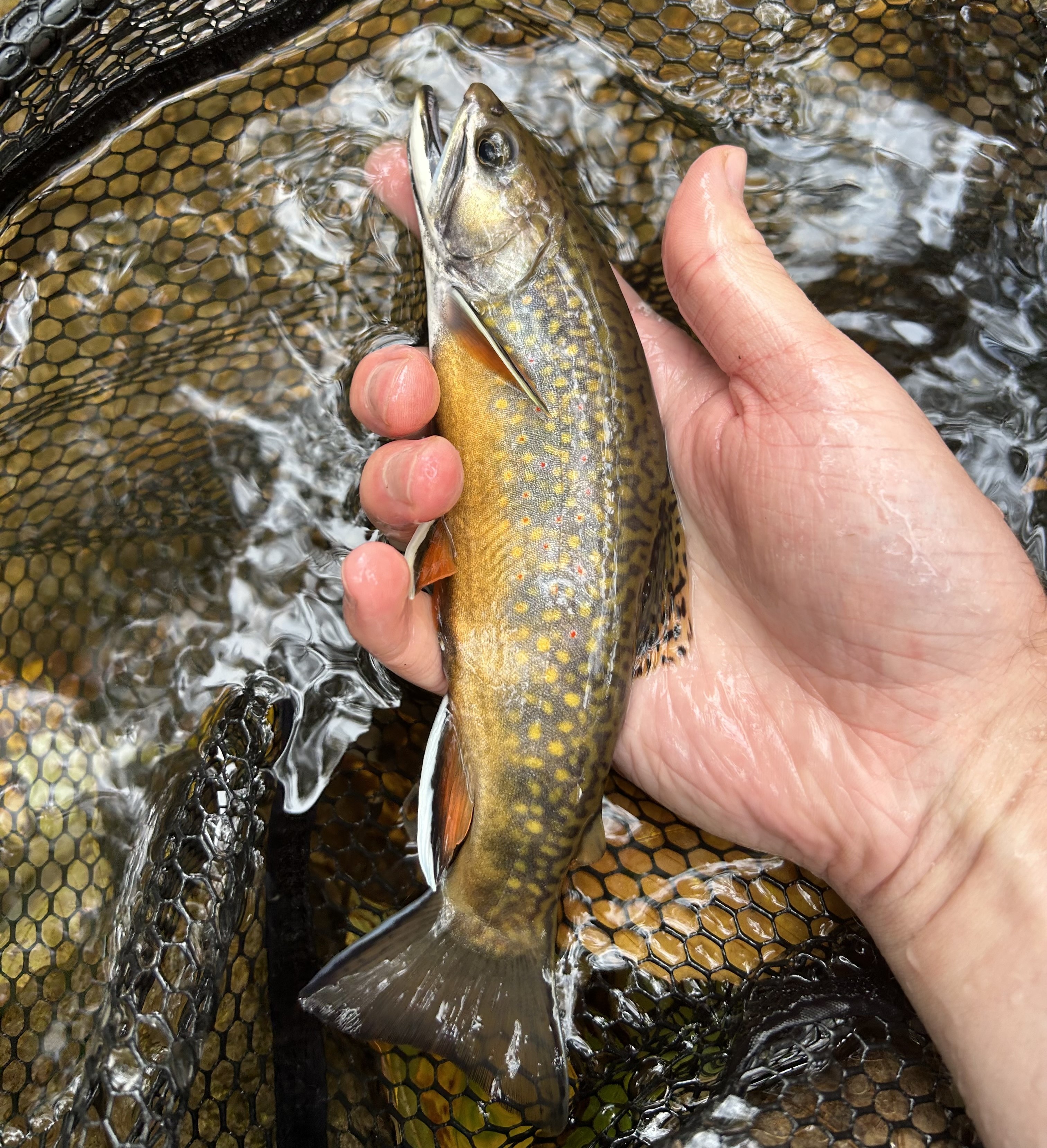

As someone who grew up there, I’m not telling you to fish or even visit New Jersey. My thoughts of the place still conjure up images of smogged out skies, smelly interstates, and concrete savannahs, just like the rest of you. But years of curiosity and exploration has added another layer to my understanding: one that contains isolated pockets of forest, unpressured fish, and forgotten dark hollows. These places exist both in seldom visited parts of this small state and in plain sight, in the form of little brook trout streams to carp that have never seen a fly. In some ways, it’s not any different than having a blue ribbon trout stream in your town—The fish are all right there, you just have to go out and get them.
So if you ever find yourself in New Jersey, by intention or not, don’t be so quick to write it off. At least go look at the water first.


